Artist Residency in Japan
September 8 - December 8, 1999
Jane was selected as one of six international
artists for a three-month artist residency program in Japan, Paper Art Village Project in Mino City '99. Jane left New York on Thurs., Sept. 9 and returned to the U.S. on Dec. 8, 1999. The residency program was in Mino City, Gifu prefecture, in the Central Highlands area of Honshu, the main island of Japan. Jane and the other artists in the program were invited by the city of Mino to participate in the 1999 Paper Art Village Project, a five-year program funded in part by the Japan Cultural Council and now in its third year. The artists participating in the "Paper Art Village Project 1999" were:Lucy Yegros, Paraguay
Mejra Mujicic, Croatia
Jane Ingram Allen, U.S.A.
Yumiko Yamazaki, Japan
Pino Barilla, Italy
Louise Giamari, France
Yoshihisa Hasegawa, Japan
Artists for the Paper Art Village Project each year are selected by a committee of art professionals after reviewing applications and slides. The residency award provides travel expenses, accommodations in Japan, studio space and materials to make artwork with Japanese handmade paper. The artists in the program represent all media, and all use paper in some way in their work. Jane is the only artist in the group who has experience making paper.
During the residency, artists
create works using Japanese handmade paper. They have been learning
papermaking from masters at the the Mino Washi Museum. The
Museum has an excellent facility with good equipment for teaching and
production of handmade paper. The kozo fiber used in Mino paper is very unique
and different from Western papermaking fibers, and it is possible
to make thin sheets and have them remain very strong.
 During her residency
During her residency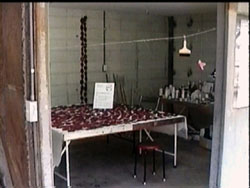 Jane
made a large installation work called "Turning Over
a New Leaf". It is made of Japanese handmade paper, acrylic paints,
horse hair string, and mesh fabric. This picture is of her studio at the
Paper Village. She making the work on the table with over 2000 handmade
paper leaves, red on one side and green on the other. This work will be
shipped to Jane in New York after the exhibition at the Mino Washi Museum and
shown in New York City at Snug Harbor Cultural Center as part of the
"Elements 2000" exhibition. Click here for more information
about this exhibition.
Jane
made a large installation work called "Turning Over
a New Leaf". It is made of Japanese handmade paper, acrylic paints,
horse hair string, and mesh fabric. This picture is of her studio at the
Paper Village. She making the work on the table with over 2000 handmade
paper leaves, red on one side and green on the other. This work will be
shipped to Jane in New York after the exhibition at the Mino Washi Museum and
shown in New York City at Snug Harbor Cultural Center as part of the
"Elements 2000" exhibition. Click here for more information
about this exhibition.
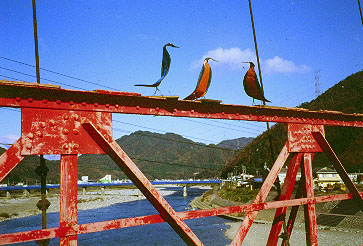
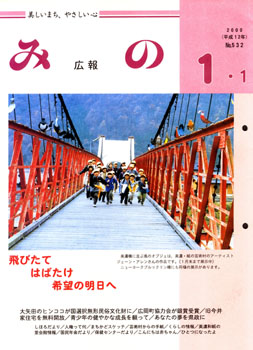 Jane also made a public art installation during her residency,
continuing her "Bird Watching" series of outdoor installation of
multiple bird forms. Jane's work "Bird Watching in
Japan" contains 28 bird sculptures arranged as a site-specific installation
on the Mino Bridge, the oldest
suspension bridge in Japan. The bridge is sort of like a miniature
Brooklyn Bridge and is used only for pedestrian and bicycle traffic now.
The birds are made of Japanese kozo fiber paper over a wire armature, painted
with acrylic paints and coated with polyurethane for outdoor use. The
installation will remain on view in Japan.
Jane also made a public art installation during her residency,
continuing her "Bird Watching" series of outdoor installation of
multiple bird forms. Jane's work "Bird Watching in
Japan" contains 28 bird sculptures arranged as a site-specific installation
on the Mino Bridge, the oldest
suspension bridge in Japan. The bridge is sort of like a miniature
Brooklyn Bridge and is used only for pedestrian and bicycle traffic now.
The birds are made of Japanese kozo fiber paper over a wire armature, painted
with acrylic paints and coated with polyurethane for outdoor use. The
installation will remain on view in Japan.
 Another work Jane made during her residency used some very thin,
transparent Mino paper to create an installation called "Different
Views," composed of multiple suspended maps showing the world from
different viewpoints. The work was inspired by the map on the wall in the
bedroom where Jane slept. Instead of the world Jane was used to
seeing-with America in the center- it was a map of the world with Japan in the
center, very large, and the U.S. very small and almost off the page on the
right. Jane's map installation was also influenced by books that
Jane has showing satellite maps of the earth and views of earth taken by
astronauts in orbit around the earth. The map pieces are made with very
thin kozo fiber paper which has bits of horsehair and horsehair thread in
it. The map images are drawn/painted with acrylic paint and
look very interesting with light coming through the thin paper showing the
contrasting transparent and opaque areas. The map installation
"Different Views" will become part of the Mino City permanent
collection and remain in Japan.
Another work Jane made during her residency used some very thin,
transparent Mino paper to create an installation called "Different
Views," composed of multiple suspended maps showing the world from
different viewpoints. The work was inspired by the map on the wall in the
bedroom where Jane slept. Instead of the world Jane was used to
seeing-with America in the center- it was a map of the world with Japan in the
center, very large, and the U.S. very small and almost off the page on the
right. Jane's map installation was also influenced by books that
Jane has showing satellite maps of the earth and views of earth taken by
astronauts in orbit around the earth. The map pieces are made with very
thin kozo fiber paper which has bits of horsehair and horsehair thread in
it. The map images are drawn/painted with acrylic paint and
look very interesting with light coming through the thin paper showing the
contrasting transparent and opaque areas. The map installation
"Different Views" will become part of the Mino City permanent
collection and remain in Japan.
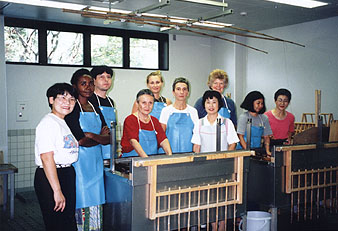 One of the goals of the Mino City
Paper Art Village Project is to develop relationships between foreign and domestic
artists and the people of Mino. Mino City is one of the main centers of
traditional papermaking in Japan and has abundant kozo fiber. The artists
all learn about Japanese papermaking and make works with Japanese paper
during their residency. The artists all exhibit work made during the
residency at the Mino Washi Museum at the end of the residency and also donate
at least one work to the permanent collection of Mino City.
One of the goals of the Mino City
Paper Art Village Project is to develop relationships between foreign and domestic
artists and the people of Mino. Mino City is one of the main centers of
traditional papermaking in Japan and has abundant kozo fiber. The artists
all learn about Japanese papermaking and make works with Japanese paper
during their residency. The artists all exhibit work made during the
residency at the Mino Washi Museum at the end of the residency and also donate
at least one work to the permanent collection of Mino City.
Mino City, is a very traditional community with approximately 60,000 people. It is located 45 km from Nagoya, the third largest city in Japan. Mino is in the area where traditional Japanese handmade paper is still being made my master craftsmen. Mino is in a scenic mountainous area with the Nagara River famous for using cormorant birds for fishing. Mino is also known for its excellent examples of traditional Udatsu architecture as well as Mino Paper, recognized by the Japanese government as an Important Intangible Cultural Heritage.
During her three month’s stay in Japan, Jane
lived with a local
family, Yasoe and Yasumi Murai and their two daughters Akiko and Takayo.
Jane also learned many Japanese customs and even some of the language. In
this photo, Jane is
walking the family dog along one of the beautiful rivers near her home.
 Jane learned to like Japanese food and tried many new and interesting things
such as eel and octopus and many other things she never knew what they
were! The diet in Japan is very different with lots of vegetables and tofu
and fish, even fish for
breakfast. Jane got very good with chop sticks, 'hashi", even
picking up tofu. The artists went to many parties in people's homes,
and all had much fun with delicious food and lots of sake and Japanese
beer. Here is a photo showing the party at the home of Mr. Watanabe, an
artist himself who was a great technical advisor for all of the artists in the
Project...he also did the design and installation of our exhibition at the Mino
Washi Museum.
Jane learned to like Japanese food and tried many new and interesting things
such as eel and octopus and many other things she never knew what they
were! The diet in Japan is very different with lots of vegetables and tofu
and fish, even fish for
breakfast. Jane got very good with chop sticks, 'hashi", even
picking up tofu. The artists went to many parties in people's homes,
and all had much fun with delicious food and lots of sake and Japanese
beer. Here is a photo showing the party at the home of Mr. Watanabe, an
artist himself who was a great technical advisor for all of the artists in the
Project...he also did the design and installation of our exhibition at the Mino
Washi Museum.
Language was the biggest challenge in Japan for Jane and the other artists. There were several volunteer translators who spoke some English and were very helpful in communication. Few people in Mino speak English, let alone the Italian and French. The artist from Italy spoke only Italian, and the artists from Paraguay and Croatia could speak some Italian. The artist from France only spoke French, and Jane can speak some French. When the artists were having their lessons from the Japanese papermaking masters who spoke only Japanese, it was a bit difficult to communicate to everyone. There were a lot of hand signals.
 Jane’s
husband Tim joined her in Japan during October for two weeks, and they traveled
to Nagoya and Kyoto. While in Kyoto they stayed with artist Kyoko Ibe, shown in the
middle here in her new studio. Kyoko Ibe
is considered one of the major paper artists in Japan and creates large scale
installations with washi and also designs many objects with handmade paper.
Jane’s
husband Tim joined her in Japan during October for two weeks, and they traveled
to Nagoya and Kyoto. While in Kyoto they stayed with artist Kyoko Ibe, shown in the
middle here in her new studio. Kyoko Ibe
is considered one of the major paper artists in Japan and creates large scale
installations with washi and also designs many objects with handmade paper.
Jane and Tim were accompanied to Kyoto by Akiko Furuta, a volunteer translator
with the Mino Paper Art Village Project. In Kyoto they were also able to see museums and galleries as well as
many temples and shrines and a traditional costume parade. Kyoto was a very friendly city with many people who came up and
talked with us in English.
Jane also went to Nagoya several times during her stay in Japan, visiting galleries and museums. In Nagoya she also got to visit with Professor Michiko Yashiro, who teaches art at the Nagoya Junior College of Art & Design. The college has wonderful facilities for all kinds of art, including ceramics, wood and metal sculpture, textile design, interior design, video and computer art as well as painting and drawing. Michiko and her husband also took Jane to the downtown Nagoya area where there are many booths for selling used clothing and other items--sort of like a giant flea market. Here Jane enjoyed buying some used kimonos as souvenirs.
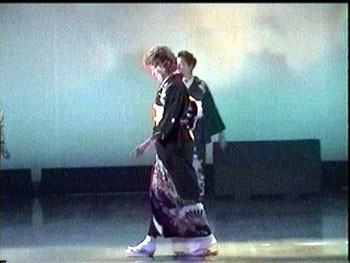 One of the most interesting experiences for the Paper Art Village Project
artists was participating as models for a kimono fashion show in the city of
Gifu. It was quite a challenge getting foreigners to look right in a
kimono...they did find one big enough for Jane! It took much pulling
tugging and readjusting to get the costume right, and Jane was told by the
Japanese ladies in charge of dressing her not to sit down until after her turn
on the stage. Kimono dressing will probably never be popular in the U.S.
or even in modern Japan because it is very tight and confining, but it does give
everyone an elegant look! Here is a photo of Jane in a beautiful black
kimono with delicate embroidery and gold braid...she was told this is what the
"mother of the bride" might wear to a traditional Japanese
wedding.
One of the most interesting experiences for the Paper Art Village Project
artists was participating as models for a kimono fashion show in the city of
Gifu. It was quite a challenge getting foreigners to look right in a
kimono...they did find one big enough for Jane! It took much pulling
tugging and readjusting to get the costume right, and Jane was told by the
Japanese ladies in charge of dressing her not to sit down until after her turn
on the stage. Kimono dressing will probably never be popular in the U.S.
or even in modern Japan because it is very tight and confining, but it does give
everyone an elegant look! Here is a photo of Jane in a beautiful black
kimono with delicate embroidery and gold braid...she was told this is what the
"mother of the bride" might wear to a traditional Japanese
wedding.
In Japan Jane also traveled to the city of Kanazawa which is further north than Mino and on the Japan Sea. In Kanazawa Jane visited with the Wakamatsu family whose son Michi is now a Rotary exchange student in Utica, New York. Just before coming to Japan in September, Jane and her husband Tim were host parents for Michi who had just arrived in the U.S. from Kanazawa. The Wakamatsu family took Jane to see art museums and traditional craftsmen's studios in the Kanazawa area as well as the famous Japanese garden in the city.
 Here
Jane is shown making a sheet of kozo paper using the traditional Japanese
methods and equipment at the Mino Washi Museum. For Japanese paper
the paper mold has a handwoven bamboo screen instead of wire screening as in
Western methods. The artists in the Paper Art Village Project visited the
woman in Mino who makes the su, or bamboo screens. The Mino su is perhaps
the best quality bamboo screen made in the world, and the process of weaving the
very thin strips of special bamboo is incredibly time consuming....I guess that
is why they are so expensive! In the Japanese method of papermaking, the
sheet is formed by dipping the mold into the vat several times and with a
traditional side to side and front to back sloshing of the pulp to form the
sheet with several very thin layers of pulp. During her stay in Mino, Jane
practiced many times to try and perfect this traditional Japanese technique for
making paper. It takes lots of practice to make consistent
sheets. One of the most difficult things to learn is how to transfer
the formed sheet off the bamboo screen. The Japanese teachers never say in
words what you are doing wrong, only show you how it is done again...an
interesting and different way of teaching.
Here
Jane is shown making a sheet of kozo paper using the traditional Japanese
methods and equipment at the Mino Washi Museum. For Japanese paper
the paper mold has a handwoven bamboo screen instead of wire screening as in
Western methods. The artists in the Paper Art Village Project visited the
woman in Mino who makes the su, or bamboo screens. The Mino su is perhaps
the best quality bamboo screen made in the world, and the process of weaving the
very thin strips of special bamboo is incredibly time consuming....I guess that
is why they are so expensive! In the Japanese method of papermaking, the
sheet is formed by dipping the mold into the vat several times and with a
traditional side to side and front to back sloshing of the pulp to form the
sheet with several very thin layers of pulp. During her stay in Mino, Jane
practiced many times to try and perfect this traditional Japanese technique for
making paper. It takes lots of practice to make consistent
sheets. One of the most difficult things to learn is how to transfer
the formed sheet off the bamboo screen. The Japanese teachers never say in
words what you are doing wrong, only show you how it is done again...an
interesting and different way of teaching.
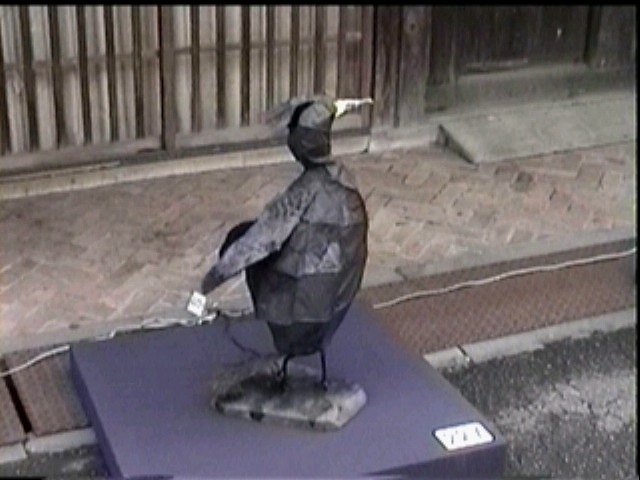 This
photo shows Jane's work "U" which is the Japanese word for the
cormorant bird. Jane created this handmade paper lantern for the
Mino City Lantern Festival, held October 17-19, along the city streets.
Each year Mino City sponsors a contest for artists to create lanterns using Mino
paper. Prizes are awarded for the best and most creative lanterns each
year by a team of judges made up of art professionals. This year Jane's
lantern was awarded a special "Honorable Mention" prize, and the
Japanese artist Yumiko Yamazaki, also in the Paper Art Village Project, received
third prize for her lantern. This was the first time Jane and the other
foreign artists had ever made a lantern. It was quite a challenge working
with new and different materials, and Jane even learned how to do some
electrical wiring. Jane decided to make her lantern in the shape of the
cormorant since this bird is very famous in the Mino area. It is used by
fishermen to catch fish in the Nagara River. The fishermen put a sort of
collar around the neck of the birds who then catch the fish for the men, but are
unable to swallow them. This type of fishing has been going on for
centuries in this area of Japan, and it is a great tourist attraction to go on a
river tour with the cormorant fishermen. Jane's lantern was also
unique in Japan because it was the only one people had ever seen which was
black; most lanterns are made with white or natural colored paper in
Japan.
This
photo shows Jane's work "U" which is the Japanese word for the
cormorant bird. Jane created this handmade paper lantern for the
Mino City Lantern Festival, held October 17-19, along the city streets.
Each year Mino City sponsors a contest for artists to create lanterns using Mino
paper. Prizes are awarded for the best and most creative lanterns each
year by a team of judges made up of art professionals. This year Jane's
lantern was awarded a special "Honorable Mention" prize, and the
Japanese artist Yumiko Yamazaki, also in the Paper Art Village Project, received
third prize for her lantern. This was the first time Jane and the other
foreign artists had ever made a lantern. It was quite a challenge working
with new and different materials, and Jane even learned how to do some
electrical wiring. Jane decided to make her lantern in the shape of the
cormorant since this bird is very famous in the Mino area. It is used by
fishermen to catch fish in the Nagara River. The fishermen put a sort of
collar around the neck of the birds who then catch the fish for the men, but are
unable to swallow them. This type of fishing has been going on for
centuries in this area of Japan, and it is a great tourist attraction to go on a
river tour with the cormorant fishermen. Jane's lantern was also
unique in Japan because it was the only one people had ever seen which was
black; most lanterns are made with white or natural colored paper in
Japan.
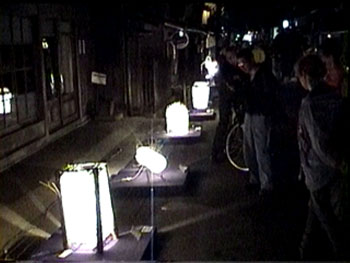 The Mino City lantern festival was a beautiful sight as the
streets in the downtown historic area were filled with many unique lighted
creations by professional artists and also a section for children's
lanterns. The festival also had many booths with food and souvenirs lining
the streets and many traditional performers presenting street performances and
playing games with the children.
The Mino City lantern festival was a beautiful sight as the
streets in the downtown historic area were filled with many unique lighted
creations by professional artists and also a section for children's
lanterns. The festival also had many booths with food and souvenirs lining
the streets and many traditional performers presenting street performances and
playing games with the children.
This residency in Japan was a great experience, and Jane has many happy memories of the people and culture of Japan. She hopes to return there in a few years to continue learning more about Japanese papermaking and create more works in Japan. Jane brought home many papers made during her residency and will continue to use these in her New York studio to make new works.
(updated on 5/29/00)